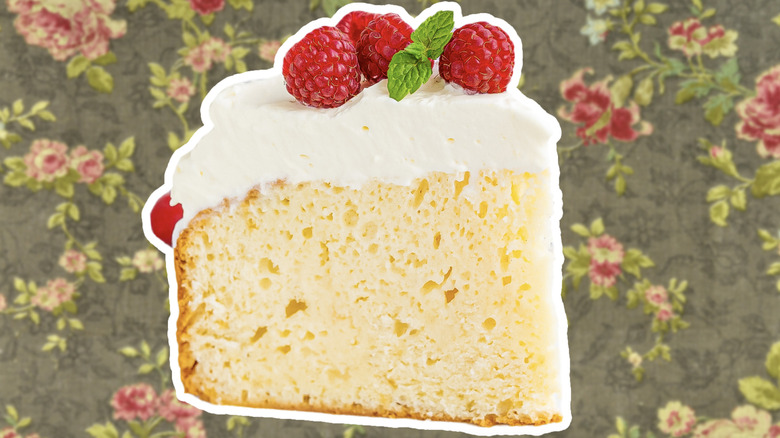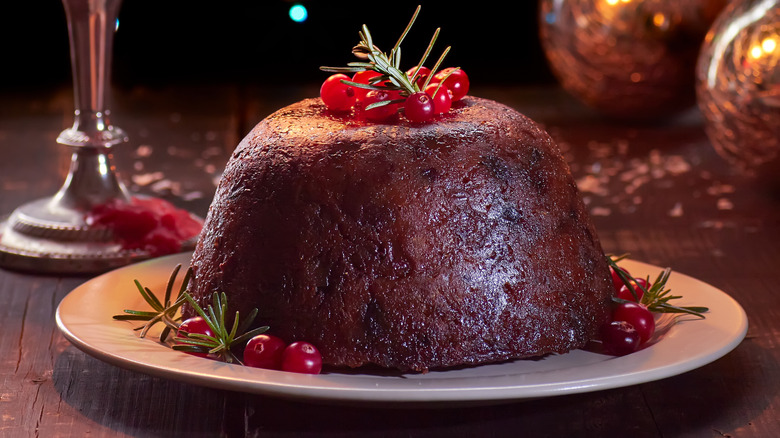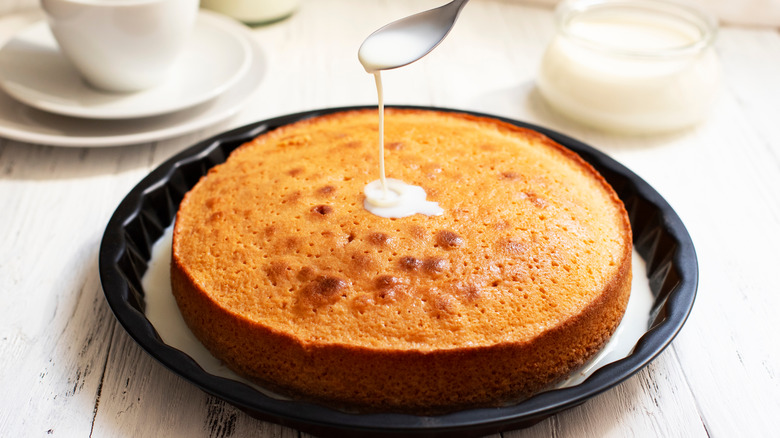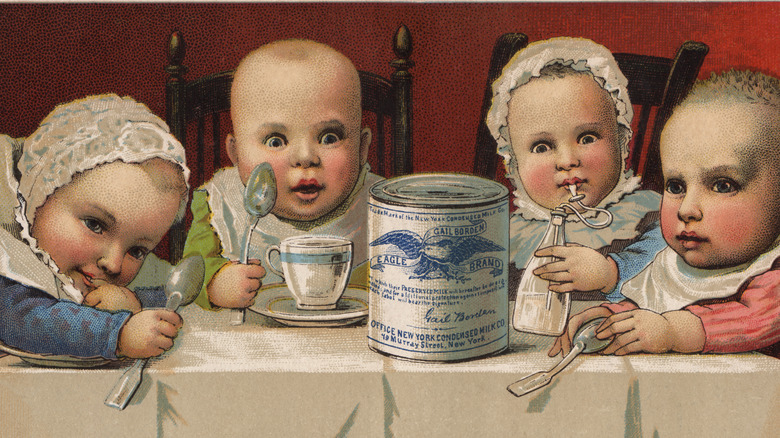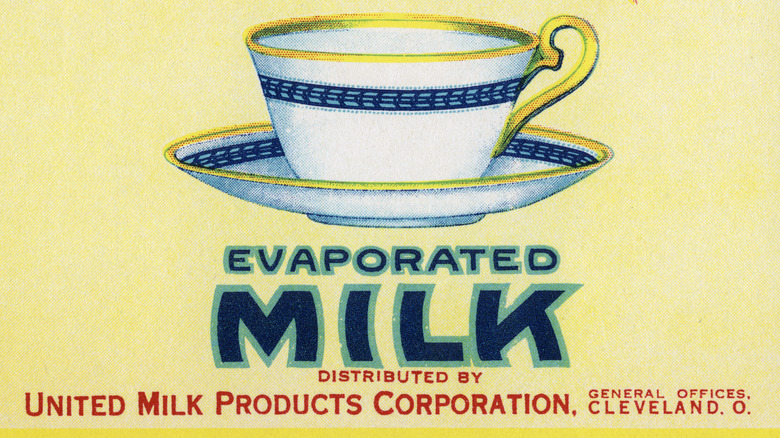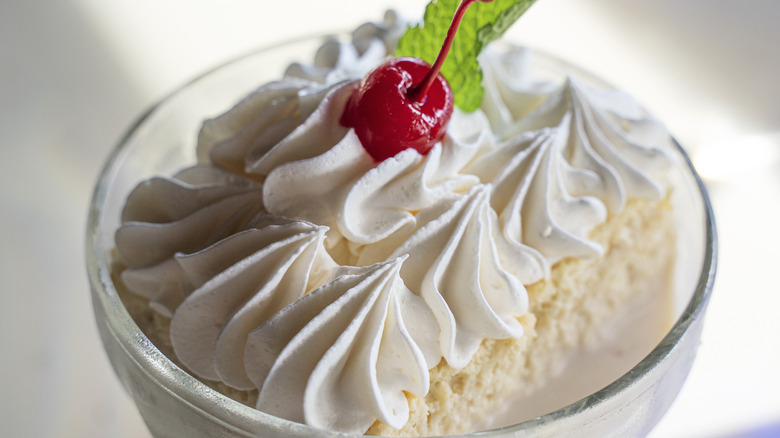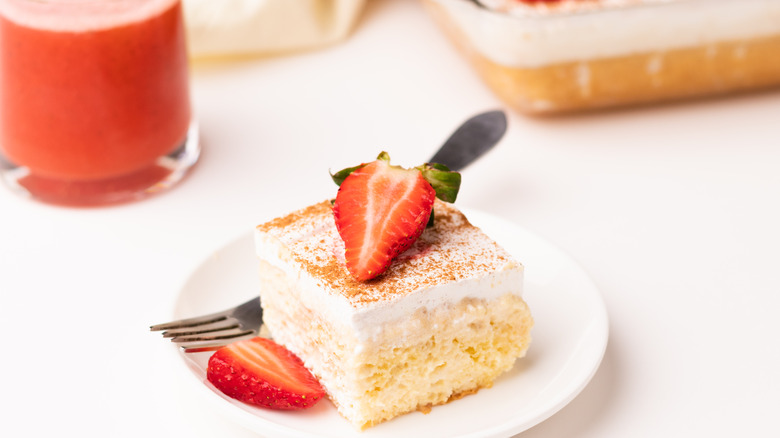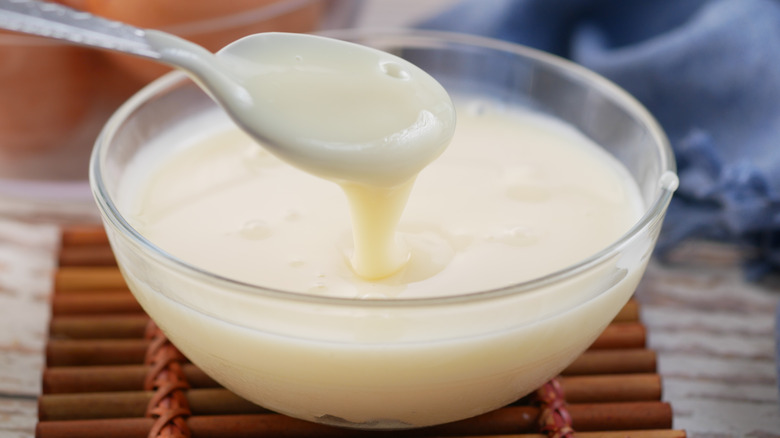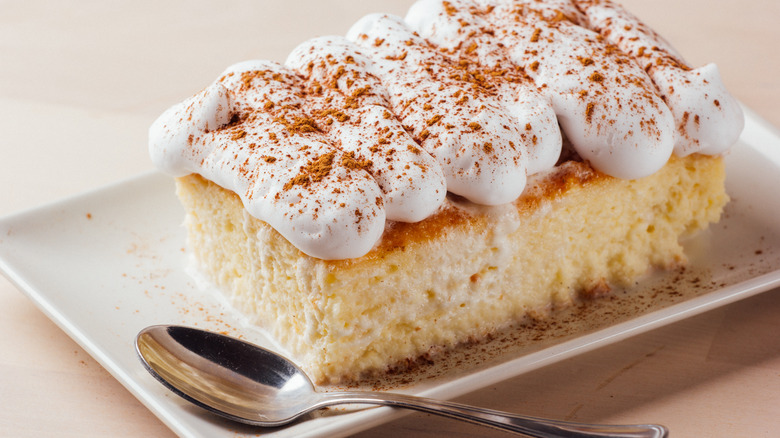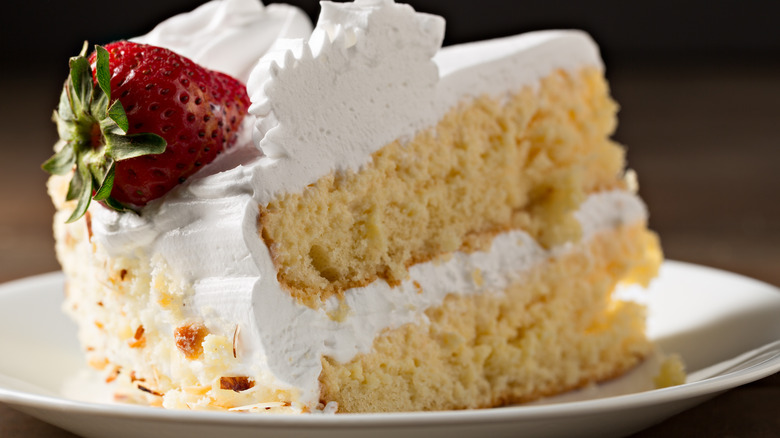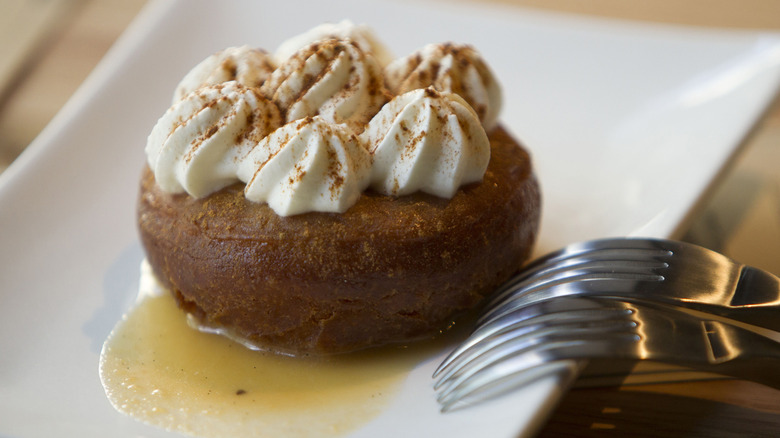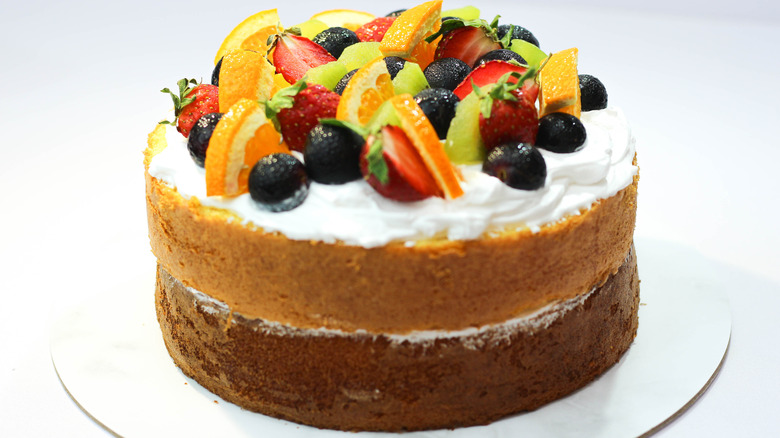The Fascinating Origin Story Of The Tres Leches Cake
Depending on who you speak to, tres leches cake could be from just about any Spanish-speaking country in Latin America — thanks to its popularity across many regions. Sweet and luxurious, tres leches cake consists of fluffy white dough that is soaked in a combination of whole milk, condensed milk, and evaporated milk — a trio that earned its name, which means three milk cake in English. However, despite the prevalence of tres leches cake, only one country can truly claim it as its own.
As New York University professor of food studies Lourdes Castro told the Wall Street Journal, "While many Latin American countries like to claim ownership to the origin of the tres leches dessert, it belongs to Nicaragua — although some claim it started in Mexico." Indeed, food historians largely concur that tres leches cake was first enjoyed in the land of lakes and volcanoes. That being said, the treat's roots can be traced back to several intense historical moments, including British colonization, the shipping boom of the 19th century and even the Great Depression.
Tres leches cake can trace its roots to England
Although tres leches cake was first created in Nicaragua, one of the main culinary techniques used in this dessert can actually trace its origins to medieval Britain. In fact, the idea of soaking sweet cakes in some type of liquid was popular in England as far back as 500 years ago. The reason for this was that in the days before refrigeration and plastic wrap, there was no good way to preserve the leftover cake. Because of this, day-old baked goods would often become crunchy and dry — a far cry from the light, fluffy dough that makes the cake so satisfying.
One of the original solutions to this problem was a trifle, a type of leftover sponge cake that was repurposed under a pile of booze, fruit, and cream. In this recipe, the mixture of alcohol and cream softened the cake, all while removing its stale flavor. Over the years, this recipe gave way to other interpretations of this same cake-rescuing method. Tipsy cakes, for example, involved soaking leftover pound cake in either sherry or brandy to help it live another day.
Meanwhile, traditional British Christmas cakes, like figgy pudding, were drenched in either cognac or rum. During the 1600s, when the British Empire entered into the cruel years of colonization, their soldiers and colonizers brought their tradition of soaking cakes around the world with them. This is seen in Jamaica's rum-soaked black cake and even in Nicaragua's tres leches cake.
Cake-soaking traditions came to Nicaragua during colonization
Like several other countries in the Americas, Nicaragua was not colonized by just one European empire. On the contrary, the country was colonized by both the Spanish and the English, with the two empires controlling different parts of the region during overlapping time periods. While the Spanish military occupied Western Nicaragua for 300 years, from 1522 to 1821, the British military also had a presence on the country's East Coast, controlling the area from 1633 to 1860.
During this turbulent and violent era, there was a lot of intercultural exchange taking place, not just between the Spaniards and the British but also among various local indigenous tribes and individuals from different parts of Africa, many of whom were being trafficked and enslaved.
From many of these interactions, new recipes were born. As the former Nicaraguan Minister of Agrarian Reform, Jamie Wheelock Roman noted in his book
"La Comida Nicaragüense" that "The colonial period gave rise to a vast process of experimentation and mixtures of food that had never before come together."
Thus, the old British tradition of soaking cakes was combined with South American products, like rum and sugar, to create the predecessors to tres leches cake. In Nicaragua, sopa borracha, a type of cake softened with honey and moonshine, became particularly popular. Legend has it that in 1566, a local lady served it to the region's governor, Don Alonso de Casaos, establishing soaked desserts as a regional staple.
The invention of condensed milk paved way for the concept of tres leches cakes
These days, it can be easy to view condensed milk as an essential dessert-making element. Used in everything from Nicaraguan tres leches cakes to pumpkin pie, this sugary yet creamy substance has become the key to bombarding our favorite sweet treats with flavor.
That being said, though, it was not that long ago that home cooks had to do without this delightful ingredient. Actually, condensed milk was not even discovered until 1853. The product first came to fruition when the U.S. inventor, Gail Borden Jr., decided to create a milk product that could be canned and stored for a long period of time.
And even once the inventor managed to make the first can of condensed milk, it took over a decade for his idea to become popular. In fact, it was not until 1864 that Borden opened a successful condensed milk factory. At the time, the American Civil War was raging on, and the U.S. government was interested in the product as a cheap and easy way to feed union soldiers.
The fighting men loved this treat, and soon condensed milk became fashionable. Although it did take some years after the war for condensed milk to grow popular in Nicaragua, its invention brought us closer to the first tres leches cake. After all, what better to soak your cake in than creamy, sugary goodness?
In the 1880s, evaporated milk also hit the market
Just like it is impossible to bake a tres leches cake without whole or condensed milk, you cannot make one without evaporated milk. Interestingly, though, this third ingredient also took a while to hit the market. Evaporated milk was not commercially available until 1885. That year, John Meyenberg and Louis Latzer began mass-producing this substance as an unsweetened answer to the ultra-sugary condensed milk alternative.
Like condensed milk, evaporated milk was popularized through military influence. During the Spanish-American War and World War I, the United States military purchased large quantities of evaporated milk to feed the troops. As American soldiers traveled across the world with these preserved milk products, the popularity of these ingredients grew. When U.S. marines headed down to Nicaragua in 1909, they brought this specific food culture along with them. U.S. troops remained in Nicaragua on and off for decades.
Over time, evaporated milk and condensed milk alike made their way into an elite part of Nicaraguan society, with the ingredients appearing in several upper-class desserts. One dish, known as delicias Suecas, was already understood to be very similar to tres leches cake. Essentially, the once-British tradition of soaking cakes was adapted to these new milk elements, resulting in sponge cakes that were doused in creamy components.
For a while, just the upper class enjoyed these treats
When condensed and evaporated milk cakes first became prevalent in Nicaraguan society, they were not available to the vast majority of the local population. In fact, the predecessors to tres leches cake — like delicias Suecas — were consumed by the upper class, who enjoyed these desserts in fine settings, such as country clubs.
Unfortunately, the rest of the social classes did not have access to condensed milk-based desserts. When these treats became popular in the early 1900s, much of the original caste system that Nicaraguans had already established, even before the arrival of the Spanish, was still in place.
Even centuries after the country's class divisions were established, those who remained in positions of power were the priests and nobles. Meanwhile, Nicaraguans of indigenous or agricultural laborer descendants were limited to difficult jobs involving low salaries and manual labor.
As a result, members of the Nicaraguan working class barely had enough resources for food, let alone fancy desserts. Around the turn-of-the-century, treats similar to tres leches would have been inaccessible to most people. At the time, the treat's major ingredients of condensed milk and evaporated milk were imported from the United States, Canada, or Switzerland, making them extremely expensive. U.S.-based dairy products.
The dish was popularized during the Great Depression
While many sweet treats — like tres leches cake or delicias Suecas — were completely out of reach for most early 20th-century Nicaraguans, this dynamic shifted a bit during the Great Depression.
Although this was a very difficult time for people across the globe, it was also the moment when canned milk products achieved a more reasonable price in Nicaragua. The reason for this unusual phenomenon was that, in 1936, the United States signed a trade agreement with Nicaragua.
This accord helped reduce local taxes on American dairy products and enabled U.S. companies to expand their operations to Nicaragua. Overall, this provision was put in place with the intention of boosting both countries economies. On one hand, the new agreement allowed U.S. vendors to sell more of their products in Nicaragua. On the other, it gave Nicaraguan home cooks the chance to access dairy products, like condensed milk and evaporated milk, at a more accessible price.
For the first time, the key ingredients in tres leches cake became available to a wider percentage of the Nicaraguan population. Sales, naturally, took off as people enjoyed a sweet treat or two during the economic crisis. As time went on, home cooks thought of more and more ways to use these fantastic ingredients, including in cake. Because of this, it is thought that the Great Depression was the era that ushered in the first official tres leches cake recipe.
The idea behind tres leches cake might have been religious
When it comes to tres leches cake, one of the most obvious questions might be why this treat involves three different kinds of milk — as opposed to four or even two. Of course, part of the reason has to do with flavor. Sweetened condensed milk can be overpoweringly sugary, and combining it with unsweetened ingredients, like evaporated milk or good old-fashioned whole milk, can help balance things out. Similarly, the thinner consistencies of traditional and evaporated milk can help moderate the almost syrupy nature of condensed milk.
In addition to the taste, there might have been another reason why Nicaraguan cooks chose to use three milk varieties in the recipe: religion. Nicaragua's Catholic culture motivated the choice to incorporate a possible trinity into the dessert. According to the Washington Post, "Triple the milk — in honor of God, his son, and the holy spirit — and baptize the cake after it's baked, and tres leches is born."
While this theory might sound far-fetched at first, there is actually a long history of Catholic cultures making desserts in the name of religion. The Washington Post also mentions that other treats, like sfogliatelle from Italy and pastéis — or pastel — de nata from Portugal, were made in monasteries and convents. With this in mind, it would not be considered outlandish to imagine that tres leches cake had strong Catholic ties, as well.
Nestle also contributed to tres leches' increase in popularity
As time went on, tres leches cake grew increasingly popular in Nicaragua. Compellingly, the sweets company, Nestlé and Borden played a major role in spreading this dessert across the country — and eventually even beyond. One of the reasons for this pertained to the company's growth. As more and more people across the globe came to love sweetened condensed milk, the more factories Nestlé had to open.
In the 1930s, the enterprise decided to establish factories in Central America, first in Mexico and eventually in Nicaragua as well. This made the main ingredients in tres leches cake even more accessible in the region. Perhaps even more important than Nestlé's growing brand, though, was a fun advertising campaign that the company ran around the same time.
In order to promote the use of its product, Nestlé would print recipe ideas on the back of condensed milk cans. Although there's no longer any evidence to confirm it, Nestlé claims one such recipe was the tres leches cake.
These unique cans were reportedly created sometime between the early to mid-1900s and sent to Latin American countries beyond just Nicaragua. Soon, new variations of tres leches cake started popping up in different parts of South America. In the Dominican Republic, for example, folks have been known to switch out cream for coconut milk to give the dish a fruitier flavor. Meanwhile, in Puerto Rico, bakers sometimes soak their cake in rum, turning up the heat.
Tres leches came to the United States and beyond
During the 1970s, Nicaragua found itself in crisis. Times got particularly tough in 1972 when an earthquake all but destroyed the country's capital city of Managua. The government did not adequately respond to the natural disaster, and civil unrest ensued. By the end of the decade, Nicaragua found itself in the midst of a civil war. Thousands of locals fled the country, heading to other destinations, ranging from Costa Rica to Guatemala.
A sizable number of Nicaraguans also headed to the United States — particularly to Miami. Of course, where these people went, they brought tres leches cake along with them. As more and more Nicaraguans poured into South Florida, tres leches cake grew increasingly popular in the region. Interestingly, it really did not take long for the dish to become a local staple.
In 1981, a Nicaraguan family opened the Los Ranchos Steakhouse restaurant in Miami. Naturally, it offered tres leches cakes as a part of the dessert menu. Sales for this treat skyrocketed so much that the owners decided to use tres leches to promote the restaurant as a whole. They even handed out fliers with their special recipe printed on them to attract new customers. Before long, all sorts of other restaurants in the area had added tres leches cakes to the menus as well, making the dessert a South Florida favorite.
Americanized versions of the dish emerged
When tres leches cake hit the U.S. market in the 1980s, it was hugely successful. And, as more and more locals enjoyed this delightful dessert, an increasing number of Americanized versions of tres leches also started to appear. One of the most obvious examples of this is tres leches pumpkin pie cake, which combines traditional American fall ingredients with the original recipe.
Compellingly, it seems that this dish was created to give a Nicaraguan twist to U.S. holiday meals — such as Thanksgiving or even Halloween. Even so, that has not stopped Americans of other ethnicities from enjoying this treat — after all, it incorporates the pumpkin spice trend that so many people enjoy in fall.
Of course, there are plenty of other Americanized iterations of tres leches. Another popular choice is the tres leches donut, which has become one of the signature flavors at the New York City gem, The Doughnut Plant. This delicious treat switches out sponge cake for thick donut dough, adding an extra layer of richness to the classic tres leches flavors.
Yet another American twist lies within marshmallow fluff, which more and more families have started to use to frost their tres leches cake. This deeply U.S.-based ingredient gives old-fashioned tres leches cakes an extra burst of sweetness, combined with an especially gooey topping. It has become so ingrained in Miami's tres leches culture that some consider it an integral part of the recipe.
New iterations of the treat keep popping up
At its core, tres leches cake is a dish that was born out of an ever-changing geo-political landscape. Over the years, the dish has transformed from a medieval British food preservation technique to an upper-class Nicaraguan status symbol to a trendy treat in American cities like Miami and New York. And, the dessert has not stopped evolving.
Nowadays, one can find all sorts of tres leches cake variations, reflecting our ever-changing culture. One clear instance of this is the gender-reveal tres leches cake, which contains either a blue or pink interior based on the sex of a family's future child. This new type of tres leches has responded to a trend that began less than 20 years ago.
Indeed, it was only in 2008 that an American mommy blogger, known as Jenna Karvunidis, threw one of the first gender reveal parties to rock the Internet — and inspired many other families to do the same. In response to this growing culture, tres leches has been adapted, becoming an integral part of how many parents-to-be discover the sex of their baby. The cake has not stopped transforming, and it is showing no signs of slowing down.
